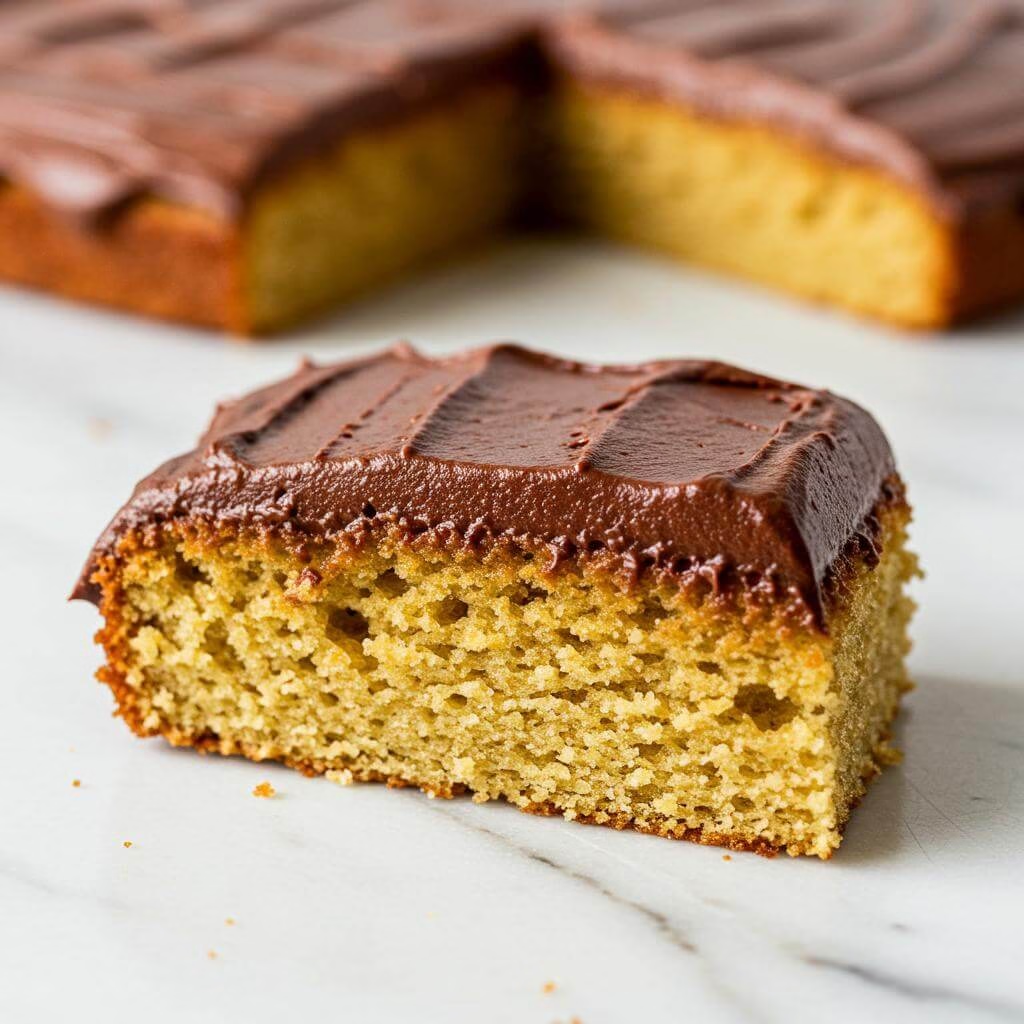
Experience the Joy of the Perfect Gluten-Free Sheet Cake
Okay, friends, gather ’round because we’re about to talk about something truly special: the simple, unadulterated joy of a perfect gluten-free sheet cake. Isn’t there something incredibly comforting about a classic yellow sheet cake? It’s the kind of bake that whispers of happy childhood memories, easy weekend afternoons, and spontaneous celebrations. Whether it’s for a bustling birthday party, a friendly potluck, or just one of those “I deserve cake” Tuesdays (we all have them!), a good sheet cake is a true kitchen hero. Finding one that fits a gluten-free lifestyle without compromising on taste or texture? That’s pure gold.
Navigating the world of gluten-free baking can sometimes feel like a quest for hidden treasure, especially when it comes to cakes. We’ve all been there – the anticipation, followed by the disappointment of a cake that’s too dry, too crumbly, or just… not quite right. But what if I told you that your search for the ultimate gluten-free sheet cake ends right here? This isn’t just any recipe; it’s *the* recipe. The one that will make you forget you’re even eating gluten-free, and the one that will have everyone, gluten-free or not, asking for your secret.
This delightful creation is wonderfully rich, unbelievably moist, and – get this – it comes together in just one bowl! Yes, you read that right. Less mess, less fuss, more time for indulging in deliciousness. It’s the kind of straightforward baking that brings pure satisfaction and makes you feel like a baking superstar. Imagine a tender crumb that melts in your mouth, perfectly sweet and vanilla-kissed. This is the gluten-free sheet cake that will have everyone asking for seconds, and maybe even thirds! If you’re looking to expand your repertoire of easy gluten-free desserts that always please a crowd, you might also love our recipe for Fudgy Gluten-Free Brownies – they’re a guaranteed hit!
One of the secrets to its success is using a good quality gluten-free all-purpose flour blend that’s designed for 1:1 substitution. This ensures the texture is spot-on, giving you that classic sheet cake feel without any of the gluten, and without any complicated conversions. Preparing this versatile gluten-free sheet cake is an absolute breeze. Forget complicated steps or exotic ingredients; this is all about simplicity and achieving a bakery-quality result in your own kitchen. Sharing a slice of this cake is like sharing a little piece of happiness. And for those extra special occasions where you want to truly impress, why not try our decadent Flourless Chocolate Fudge Cake for a different kind of rich indulgence?
So, get ready to embrace the ease and joy of baking this incredible gluten-free sheet cake. It’s more than just a recipe; it’s a promise of delicious moments, shared smiles, and the wonderful realization that gluten-free living can be absolutely, unequivocally scrumptious. This cake isn’t just for special occasions; it’s for making any day feel a little more special, proving that a gluten-free diet can be full of delightful treats. If you’re planning a celebration, this cake is a fantastic and reliable choice, alongside other crowd-pleasers like our elegant Gluten-Free Tiramisu, which always impresses guests.
Why This Gluten-Free Sheet Cake Recipe Works Miracles
Get ready to discover the secrets behind a truly exceptional gluten-free sheet cake! If you’ve ever felt intimidated by gluten-free baking, or perhaps been disappointed by dry, crumbly, or dense results, this recipe is here to change everything. What makes this particular gluten-free sheet cake stand out? It’s a brilliant combination of carefully chosen ingredients and smart techniques that work together seamlessly to mimic the structure, moisture, and tender crumb we all love in a classic vanilla sheet cake, but without any gluten whatsoever. Let’s break down the magic!
The Power of the Right Gluten-Free Flour Blend
At the heart of any successful gluten-free baked good is the flour blend, and this recipe wisely calls for a high-quality 1:1 blend like Bob’s Red Mill. Why is this so crucial for our gluten-free sheet cake? Wheat flour contains gluten proteins, which develop into a network when mixed with liquid, providing structure, elasticity, and chewiness. Gluten-free flours lack this inherent structure. A good 1:1 blend is specifically formulated to replace wheat flour cup-for-cup in many recipes. These blends typically combine several different flours – often a mix of starches (like tapioca or potato starch for tenderness and binding) and whole-grain flours (like rice, sorghum, or millet for structure, flavor, and nutrition). This multi-flour approach is essential because no single gluten-free flour can replicate the functions of wheat gluten on its own.
Furthermore, many 1:1 blends, including the recommended one, contain a binder like xanthan gum. This is a critical component for achieving a moist and well-structured gluten-free sheet cake. Xanthan gum acts as a hydrocolloid, meaning it has a strong affinity for water. When hydrated, it creates a viscous, gel-like substance that helps to bind the gluten-free flour particles together, trap air bubbles (created by leavening agents), and provide elasticity. Without it, gluten-free cakes can crumble easily. If your chosen blend *doesn’t* contain xantham gum, the recipe wisely instructs you to add it, ensuring you get that essential structure that prevents your beautiful gluten-free sheet cake from falling apart.
The Genius of the “Cut In” Method for Tenderness
This recipe employs a technique often used in pastry or biscuit making – cutting in softened butter into the dry ingredients before adding the wet. While in traditional baking this might create flaky layers, in a gluten-free cake, it serves a slightly different, yet equally vital, purpose. By coating the individual particles of the gluten-free flour blend with fat (butter), it helps to tenderize the mixture and prevent the starches from becoming overly hydrated and potentially gummy. This “shortening” effect creates tiny pockets of fat throughout the batter. As the cake bakes, the butter melts, leaving behind small air pockets and contributing to a wonderfully soft, delicate, and tender crumb texture – that sought-after “boxed cake” feel mentioned in the recipe – which can be challenging to achieve in gluten-free baking. This is a key reason this gluten-free sheet cake avoids the common pitfalls of dryness or a tough texture.
The Dynamic Duo: Butter and Oil for Ultimate Moisture
The recipe cleverly uses *both* softened butter and oil. Butter provides rich flavor and contributes to tenderness and structure through the creaming/cutting method. However, oil remains liquid at room temperature, unlike butter. This means oil contributes moisture more effectively throughout the cake’s lifespan, keeping it incredibly moist and preventing the dryness that can plague gluten-free baked goods as they cool. The combination ensures both excellent flavor and a consistently soft, moist texture for your gluten-free sheet cake, from the first slice to the last crumb.
Eggs: The Unsung Heroes of Gluten-Free Structure
The recipe uses three large eggs, and rightfully so! In gluten-free baking, eggs play an even more significant role than in traditional baking because they help compensate for the lack of gluten structure. Eggs are multifunctional powerhouses:
- Binding: Egg proteins coagulate when heated, creating a structural network that holds the cake together. They are crucial binders in the absence of gluten.
- Leavening: Beating eggs incorporates air, and the steam generated from their water content during baking contributes to the cake’s rise.
- Moisture and Richness: The fat in egg yolks adds richness and contributes to a moist crumb.
It’s clear why the recipe notes that omitting eggs isn’t likely to work – they are fundamental to giving this gluten-free sheet cake the necessary lift and stability.
Leavening Agents Working Overtime
This recipe utilizes both baking powder and baking soda. Baking powder is a complete leavener, containing both an acid and a base, and reacts when wet and again when heated. Baking soda is a base and requires an acid to react. The milk in the recipe acts as that acid. Using both provides a powerful lift and helps to create that light and fluffy texture characteristic of a great sheet cake. This dual leavening system is essential to ensure the batter rises appropriately, overcoming the potential density issues that can occur with gluten-free flours.
The Simplicity of the One-Bowl Method & Minimal Mixing
The instruction to mix the wet ingredients into the dry/butter mixture and only mix until “smooth and fluffy, about one minute” is critical. In gluten-free baking, you don’t need to worry about developing gluten by overmixing. However, overmixing can still negatively impact texture by potentially making the crumb tough or gummy, especially with some starches or if the binder is overdeveloped. The one-bowl method minimizes handling, and the specific instruction ensures the ingredients are just combined and emulsified, leading to a tender, rather than tough, gluten-free sheet cake.
In summary, this gluten-free sheet cake recipe is a triumph because it thoughtfully addresses the unique challenges of baking without gluten. By selecting an appropriate flour blend with a binder, utilizing both butter and oil for moisture and tenderness, leveraging the binding and leavening power of eggs, employing a dual leavening system, and using a gentle mixing method, it creates a cake that doesn’t just *work* but excels in texture, moisture, and flavor. Baking this gluten-free sheet cake is a rewarding experience, proving that going gluten-free doesn’t mean sacrificing delicious, comforting baked goods. Enjoy every single delightful bite!

🎁 33 Gluten-Free Breakfasts
Start every day with a smile and flavor. Get our FREE recipe eBook!
Ingredients, Nutritional Information, and Additional Tips
Ingredients
Creating a delicious gluten-free sheet cake starts with selecting quality ingredients. Here is the complete list needed for this foolproof recipe:
- 2 ¼ cups Bob’s Red Mill 1:1 Gluten-Free Baking Flour (10 ½ ounces; 297 grams): This is a pre-mixed blend designed to replace traditional wheat flour cup-for-cup. It typically contains a mix of rice flours, sorghum flour, tapioca starch, potato starch, and importantly, xanthan gum, which helps provide structure and binding in gluten-free baking. If using a different blend, check if it contains xanthan gum or plan to add the recommended amount mentioned in the recipe notes.
- 1 ½ cups granulated sugar (10 ½ ounces; 297 grams)
- 2 teaspoons baking powder
- ½ teaspoon baking soda
- ¼ teaspoon salt
- ¼ cup softened butter (2 ounces; 56 grams): Softened butter is key here for incorporating it effectively into the dry ingredients, contributing to the cake’s tender crumb.
- 1 cup milk (8 ounces; 226 grams)
- ¼ cup canola oil (1 ¾ ounces; 50 grams): A neutral oil like canola adds moisture and tenderness to the finished gluten-free sheet cake without adding distinct flavor.
- 3 large eggs: Eggs provide structure, richness, and lift. They are crucial for the texture of this specific gluten-free sheet cake.
- 1 ½ teaspoons vanilla extract: Enhances the flavor profile of the vanilla sheet cake.
For the Vanilla Frosting:
- 1 cup softened butter (8 ounces; 226 grams)
- 4 cups powdered sugar (16 ounces; 170 grams)
- 4 tablespoons milk (2 ounces; 56 grams)
- 1 teaspoon vanilla extract
Nutritional Information
While a delicious gluten-free sheet cake is certainly a treat and not a health food centerpiece, making it gluten-free is a significant nutritional benefit for those who need to avoid gluten. This recipe allows individuals with celiac disease, gluten sensitivity, or those choosing a gluten-free lifestyle to safely enjoy a classic comfort dessert. The primary benefit is ensuring that this delightful gluten-free sheet cake is free from wheat, barley, and rye.
Specific nutritional counts will vary based on the exact ingredients used (especially if making substitutions), but generally, this vanilla sheet cake provides carbohydrates, fats, and some protein from the eggs and dairy/dairy-free alternatives. Enjoying a slice is about the simple pleasure of a homemade gluten-free treat!
Substitutions, Variations & Tips
Empower your baking by understanding how to adapt this gluten-free sheet cake recipe to your specific needs and tastes!
- Gluten-Free Flour Substitution: This recipe was developed and tested using Bob’s Red Mill 1:1 Gluten-Free Baking Flour for optimal results. If you need to use a different 1:1 gluten-free blend, the outcome can vary because blends differ in composition. Ensure your chosen blend contains xanthan gum. If it does not, add ½ teaspoon of xanthan gum to the dry ingredients. Xanthan gum is vital in gluten-free baking as it mimics the binding properties of gluten, helping the cake hold together and giving it structure.
- Dairy-Free Adaptation: Easily make this gluten-free sheet cake dairy-free! Replace the softened dairy butter with an equal amount of softened dairy-free margarine or softened refined coconut oil (refined offers less coconut flavor). Substitute the dairy milk with your favorite unsweetened dairy-free milk alternative like almond, soy, oat, or rice milk. *Avoid* using full-fat canned coconut milk in the cake batter, as it is too heavy and can change the texture.
- Egg Substitution: Unfortunately, this specific vanilla sheet cake recipe relies heavily on eggs for its structure and texture. Attempting to substitute them with egg replacers is not recommended for this formula and would likely result in a significantly different, possibly unsuccessful, outcome.
- Oil Substitution: Other neutral-flavored oils like vegetable oil or grapeseed oil can be substituted for canola oil.
Creative Variations for Your Gluten-Free Sheet Cake:
- Cupcakes: Yes, you can turn this batter into delicious gluten-free cupcakes! Simply scoop the batter into 24 lined or well-greased cupcake cups and bake. Baking time will be shorter, likely around 18-25 minutes; test with a toothpick for doneness.
- Round Layer Cake: You can divide the batter evenly between two greased and floured (use gluten-free flour!) 8-inch round cake pans to make a simple two-layer gluten-free cake. Baking time might need slight adjustment.
- Frosting Fun: While the included vanilla frosting is classic, feel free to top your gluten-free sheet cake with your favorite! Chocolate frosting, cream cheese frosting, or even a simple glaze would be wonderful.
- Add-Ins: Stir ½ to 1 cup of mini chocolate chips, sprinkles, or even citrus zest (lemon or orange) into the batter before baking for extra flavor and texture.
- Extracts: Swap some of the vanilla extract for almond extract or lemon extract for a different flavor profile.
Helpful Tips for Baking Your Gluten-Free Sheet Cake:
- One-Bowl Method: Embrace the simplicity! This recipe is designed to minimize dishes by mixing everything in one large mixing bowl after the initial butter incorporation step.
- Cutting in Butter: The step where you mix the softened butter into the dry ingredients *before* adding wet components is key. It creates tiny pockets of fat coated by the flour mixture, which helps tenderize the cake and contributes to that desirable “boxed cake” like texture.
- Pan Prep: For easy serving directly from the pan, simple nonstick spray is sufficient. If you plan to remove the cooled gluten-free sheet cake from the pan before frosting (perhaps to place it on a serving platter), lining the pan with parchment paper, ensuring some overhang, is highly recommended. Don’t forget to grease the parchment too!
- Doneness Test: A classic way to check if your gluten-free sheet cake is baked through is to insert a toothpick or cake tester into the center. It should come out clean with no wet batter attached (a few moist crumbs are okay).
- Freezing: This gluten-free sheet cake freezes beautifully once cooled. You can even frost it before freezing! Wrap it tightly in plastic wrap and then foil or place it in a freezer-safe container. Thaw overnight in the refrigerator.
Enjoy creating and sharing this wonderful gluten-free sheet cake!
Essential Equipment for This Recipe
To prepare this delicious recipe, you’ll need the following kitchen tools:
- Mixing Bowls – A set of good quality mixing bowls is essential for combining wet and dry ingredients.
Find Mixing Bowls on Amazon - Measuring Cups and Spoons – Accurate measuring is crucial for baking success.
Find Measuring Cups and Spoons on Amazon - Baking Sheets – Perfect for baking cookies, roasting vegetables, and more.
Find Baking Sheets on Amazon - Whisks – For incorporating air and blending ingredients smoothly.
Find Whisks on Amazon - Spatulas – Ideal for folding ingredients and scraping bowls clean.
Find Spatulas on Amazon - Food Processors – Great for chopping vegetables quickly.
Find Food Processors on Amazon - Saucepans – A versatile tool for cooking sauces and more.
Find Saucepans on Amazon - Chef’s Knives – A good chef’s knife makes chopping a breeze.
Find Chef’s Knives on Amazon - Cutting Boards – Protect your countertops while preparing ingredients.
Find Cutting Boards on Amazon
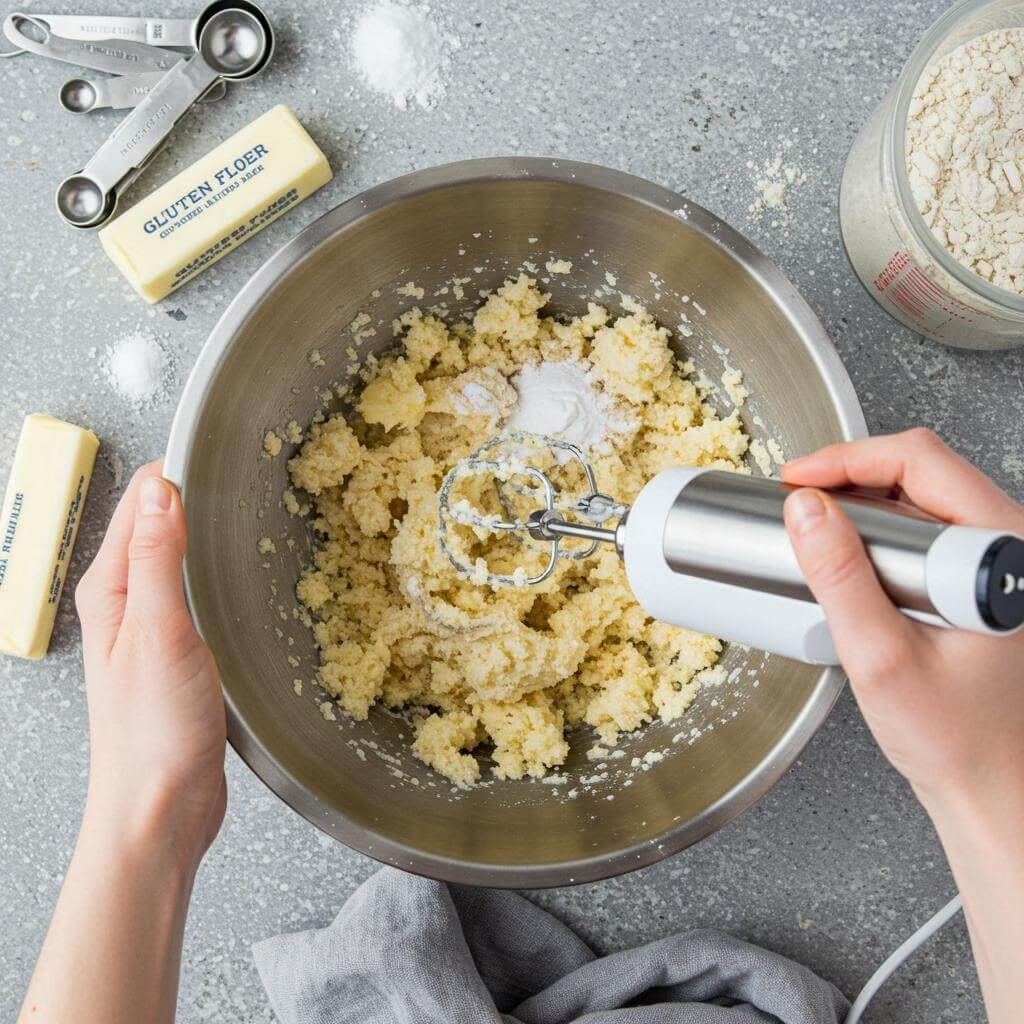
- Prepare Your Baking Pan: Begin by preheating your oven to 350°F (175°C). Proper pan preparation is key for any great bake, especially for a gluten-free sheet cake! For easy serving directly from the pan, simply grease a standard 9×13-inch `baking pan` (https://www.amazon.com/gp/search?tag=reda04b-20&keywords=9×13+baking+pan) generously with nonstick cooking spray. If you plan to remove the cake from the pan before frosting and serving, line the bottom and up the sides of the 9×13-inch pan with `parchment paper` (https://www.amazon.com/gp/search?tag=reda04b-20&keywords=parchment+paper), leaving some overhang on the long sides to act as handles. Then, grease the parchment paper and any exposed pan sides with nonstick cooking spray as well. This double layer of protection ensures your beautiful gluten-free sheet cakelifts out easily.
- Combine Dry Ingredients and Butter: In a large `mixing bowl` (https://www.amazon.com/gp/search?tag=reda04b-20&keywords=large+mixing+bowl), whisk together the gluten-free all-purpose flour blend (ensure it contains xanthan gum or add ½ teaspoon if not), granulated sugar, baking powder, baking soda, and salt. Make sure these dry ingredients are well combined before moving on. Add the softened butter (it should be at room temperature, yielding slightly when pressed). Using a stand mixer fitted with the paddle attachment or a `hand mixer` (https://www.amazon.com/gp/search?tag=reda04b-20&keywords=hand+mixer) on medium speed, mix the softened butter into the dry ingredients. Continue mixing until the butter is fully incorporated into the mixture, resembling coarse crumbs or small peas. This technique, often called ‘cutting in’ the butter, helps create that wonderfully tender texture characteristic of a classic sheet cake.
- Add Wet Ingredients and Mix Batter: To the butter-flour mixture in the bowl, add the milk, canola oil, large eggs, and vanilla extract. Increase the mixer speed to medium and mix the batter until it is smooth and fluffy. This usually takes about one minute. Be careful not to overmix the batter once the wet ingredients are added, as this can sometimes lead to a tougher texture in gluten-free baking. Just mix until everything is uniformly combined and looks light and smooth.
- Bake the Sheet Cake: Pour the smooth batter evenly into the prepared 9×13-inch pan. Use a spatula or the back of a spoon to spread it out into all the corners, ensuring an even layer for consistent baking. Place the pan in your preheated 350°F (175°C) oven. Bake the gluten-free sheet cake for approximately 30 minutes. The cake is ready when a `cake tester` (https://www.amazon.com/gp/search?tag=reda04b-20&keywords=cake+tester) or toothpick inserted into the center comes out clean with no wet batter attached. A few moist crumbs are okay. The edges should look set and slightly golden.
- Cool the Cake: Once baked, remove the gluten-free sheet cake from the oven and place the pan on a wire rack to cool completely. It’s crucial that the cake is fully cooled before you attempt to frost it; otherwise, your frosting will melt and slide right off.
- Prepare the Frosting: While your cake is cooling, you can whip up the delicious vanilla frosting. In a `medium mixing bowl` (https://www.amazon.com/gp/search?tag=reda04b-20&keywords=medium+mixing+bowl), beat the softened butter (again, room temperature is best for smooth frosting) until it is creamy and smooth. Gradually add the powdered sugar (you might sift it first for an extra smooth frosting), milk, and vanilla extract. Mix on low speed initially to prevent a cloud of powdered sugar, then increase the speed slightly and beat until the frosting is smooth and spreadable. If it seems too thick, add a tiny bit more milk; if too thin, add a little more powdered sugar.
- Frost and Enjoy: Once the gluten-free sheet cake is completely cool to the touch, spread the prepared vanilla frosting evenly over the top. Use an offset spatula for a smooth finish or create peaks and swirls for a more rustic look. Slice and enjoy your perfectly baked, moist, and delicious gluten-free sheet cake!

Tips for Perfect Gluten-Free Sheet Cake Results
Ready to bake the most delicious, moist gluten-free sheet cake? Baking gluten-free can sometimes feel tricky, but with a few simple tips tailored for working without gluten, you’ll achieve amazing results every time. Think of these as your secret weapons for a truly fantastic gluten-free sheet cake!
- Weigh Your Gluten-Free Flour: This is perhaps the single most important tip for consistent gluten-free baking, especially for something like a gluten-free sheet cake. Measuring by volume (cups) can vary wildly depending on how packed the flour is. Using a digital scale to measure your flour (10 ½ ounces or 297 grams) ensures you have the exact amount specified in the recipe, preventing a dense or dry cake.
- Use Room Temperature Ingredients: Ensure your eggs, milk, and softened butter are at room temperature. Cold ingredients don’t emulsify as well, meaning the fat (butter, oil) and liquid (milk, eggs) won’t combine smoothly. This can lead to a less uniform crumb and potentially a tougher gluten-free sheet cake. Plan ahead and take them out of the fridge 30-60 minutes before you start.
- Don’t Skip the “Cut In” Step: The recipe specifically mentions cutting in the softened butter before adding wet ingredients. This is a technique that coats the gluten-free flour particles with fat, which helps create that tender, almost “boxed mix” texture mentioned. Don’t overwork it – small, pea-sized pieces of butter are perfect before adding the liquids for your gluten-free sheet cake batter.
- Mix Just Until Combined and Fluffy: Once the wet ingredients are added, mix only until the batter is smooth and fluffy, as the recipe states, about one minute. Overmixing gluten-free batters can sometimes activate binders like xanthan gum too much, leading to a slightly gummy texture. Stop as soon as everything is incorporated and looks smooth.
- Perfect Your Pan Prep: If you plan to serve the gluten-free sheet cake directly from the pan, a simple spray is fine. However, if you want to remove the cake cleanly (highly recommended for frosting evenly or cutting perfect squares), lining the pan with parchment paper is a game-changer. Make sure the parchment hangs over the edges – those ‘handles’ make lifting the cooled gluten-free sheet cake out effortless.
- Test for Doneness Accurately: Gluten-free cakes can look done on the outside but still be wet inside. Use a wooden skewer or cake tester inserted into the very center of the gluten-free sheet cake. It should come out clean with no wet batter attached (a few moist crumbs are okay). Baking time can vary significantly based on your oven, so testing is key!
- Cool Properly: Allow the gluten-free sheet cake to cool in the pan for the time specified in the recipe or until the pan is just warm to the touch. Then, if you used parchment, lift it out onto a wire rack to cool completely before frosting. Cooling on a rack allows air circulation, preventing the bottom from becoming soggy and ensuring a firm structure for your gluten-free sheet cake.
Common Mistakes to Avoid with Your Gluten-Free Sheet Cake
Even with the best recipe for a gluten-free sheet cake, tiny missteps can lead to frustrating results. Here are a few common pitfalls to watch out for:
- Using the Wrong Flour Blend: As the recipe mentions, using the recommended Bob’s Red Mill 1:1 or a high-quality blend *with* xanthan gum is crucial. Generic or single gluten-free flours behave very differently. Using a blend without a binder will result in a crumbly, fragile gluten-free sheet cake that won’t hold together. If your blend doesn’t have xanthan gum, add the ½ teaspoon as suggested.
- Over-Baking: Because gluten-free cakes lack the elasticity of gluten, they can dry out very quickly when over-baked. A dry gluten-free sheet cake is dense and crumbly. Always start checking for doneness at the lower end of the baking time range and use the skewer test. Taking it out just as the center tests clean is perfect.
- Frosting a Warm Cake: Patience is key! Attempting to frost your gluten-free sheet cake before it has completely cooled will result in melted, messy frosting and potentially tear the delicate cake structure. Ensure the cake is absolutely cool to the touch before you even think about whipping up that delicious frosting!
Frequently Asked Questions
What’s the best gluten-free flour to use for this sheet cake, and can I use a different kind?
This recipe was specifically developed and tested using Bob’s Red Mill 1:1 Gluten-Free Baking Flour because it consistently gives the best results for this gluten-free sheet cake. Gluten-free flour blends can vary a lot! If you need to use a different 1:1 blend, make absolutely sure it contains xanthan gum, or add ½ teaspoon of xanthan gum yourself. Xanthan gum is really important in gluten-free baking for helping the cake hold together and have good structure.
I need a dairy-free version! Can this gluten-free sheet cake recipe be adapted?
Absolutely, yes! It’s quite easy to make this delicious gluten-free sheet cake dairy-free. Simply swap the softened dairy butter for an equal amount of softened dairy-free margarine or softened refined coconut oil. For the milk, use your favorite unsweetened dairy-free milk alternative like almond, soy, oat, or rice milk in the same amount. Just be sure not to use full-fat canned coconut milk in the cake batter, as it’s too heavy and will affect the texture.
Can I make this gluten-free sheet cake without eggs?
Unfortunately, this specific vanilla sheet cake recipe relies heavily on eggs for its structure, richness, and lift. Based on how it was developed, attempting to substitute the eggs with typical egg replacers is not recommended and would likely result in a much different texture, and possibly an unsuccessful cake. We don’t recommend trying to make this particular recipe egg-free.
Can I turn this gluten-free sheet cake batter into cupcakes or a round cake instead?
Yes, you sure can! This versatile batter works well for other shapes. To make gluten-free cupcakes, scoop the batter into 24 standard cupcake cups. Make sure they are lined with paper liners or very generously sprayed with nonstick cooking spray. The baking time will be shorter, usually between 18-25 minutes; test with a toothpick. To make a simple two-layer gluten-free cake, divide the batter evenly between two 8-inch round cake pans that have been greased and floured (using gluten-free flour!). Baking time might need slight adjustments here too.
The recipe makes a large batch of gluten-free sheet cake. Can I freeze it for later?
Great news, this gluten-free sheet cake freezes beautifully! Just make sure the cake is completely cooled before wrapping it up. You can even frost it before freezing – frosted cakes freeze really well. Wrap the fully cooled and potentially frosted cake tightly in plastic wrap, then foil, or place it in a freezer-safe container. When you want a slice, thaw it overnight in the refrigerator.
The recipe mentions two ways to prep the pan (just greasing vs. parchment paper). Why?
How you prep the pan depends on how you plan to serve your gluten-free sheet cake! If you’re going to serve the cake directly from the 9×13-inch pan (which is common for sheet cakes!), simply greasing the pan well with nonstick spray is enough for easy scooping. However, if you want to lift the entire cooled cake out of the pan before frosting or serving (maybe to put it on a nice platter), lining the pan with parchment paper, ensuring some overhang on the sides, and then greasing the parchment is highly recommended. The overhang acts as handles to easily lift the finished gluten-free sheet cake out.
Why do I “cut in” the softened butter at the beginning? What does that do for the gluten-free sheet cake?
That step where you mix the softened butter into the dry ingredients *before* adding the wet ingredients is a key technique for this specific gluten-free sheet cake! It’s sometimes called “cutting in” the butter. What it does is create tiny pockets of fat coated by the flour mixture throughout the batter. As the cake bakes, these fat pockets melt, helping to tenderize the cake and contributing to that lovely, delicate crumb texture that’s often described as being similar to a classic boxed cake mix.

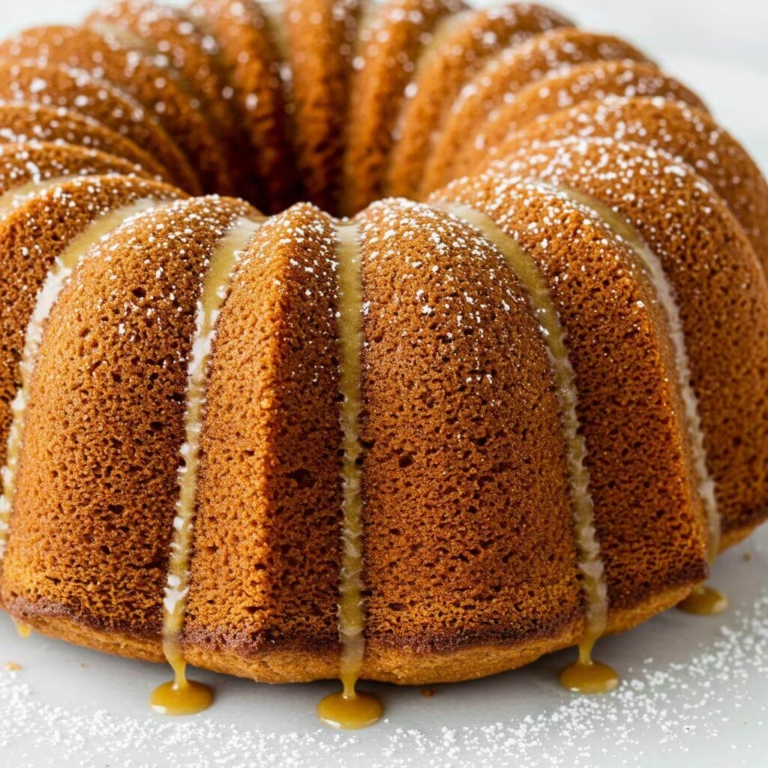

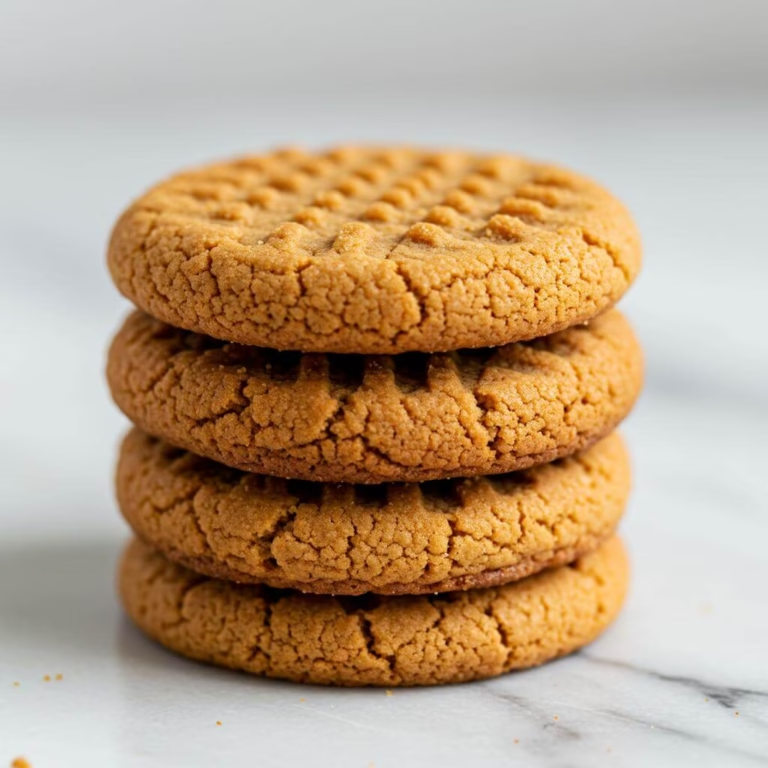

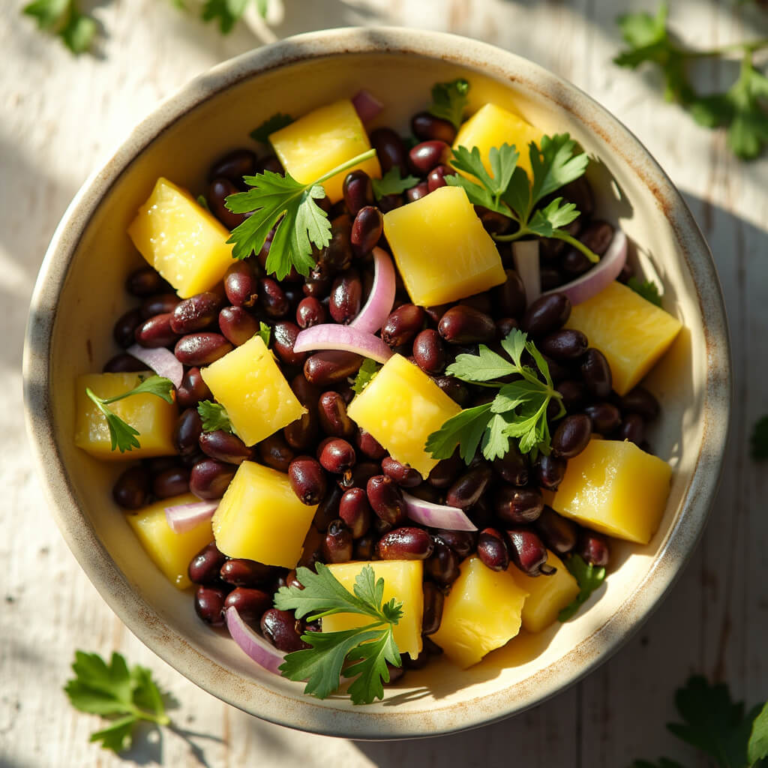
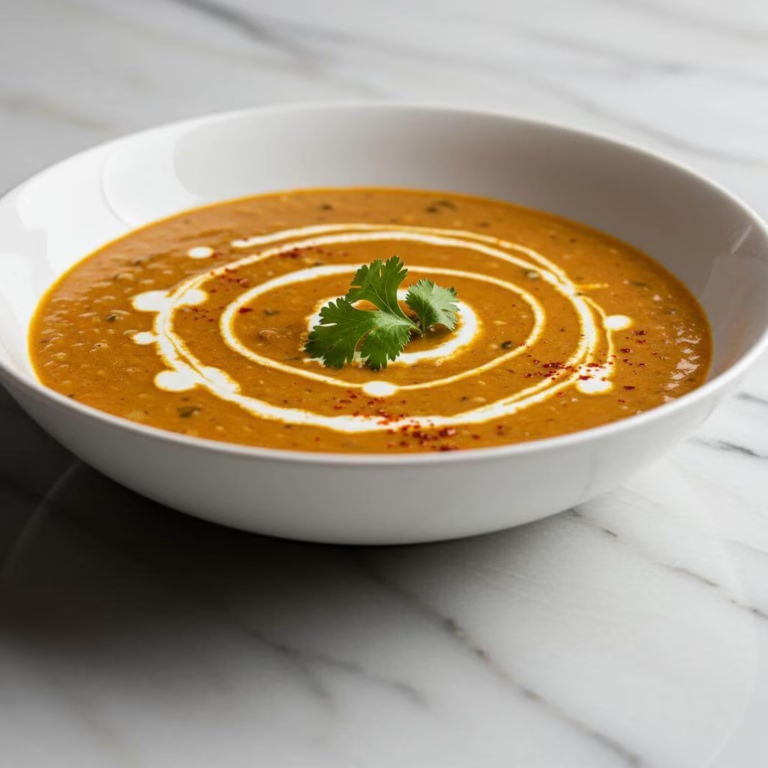
One Comment